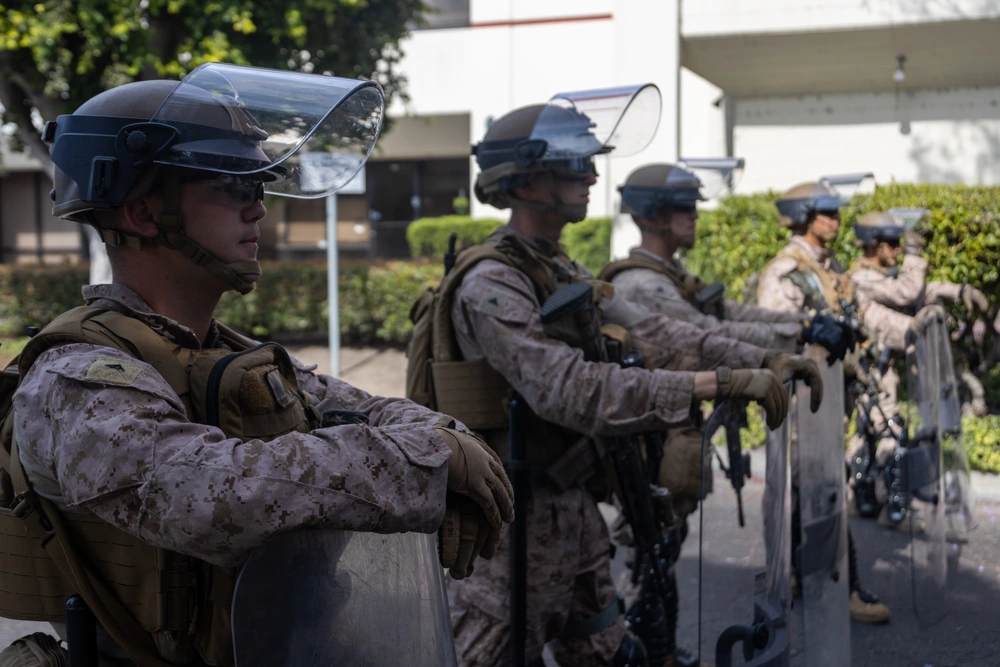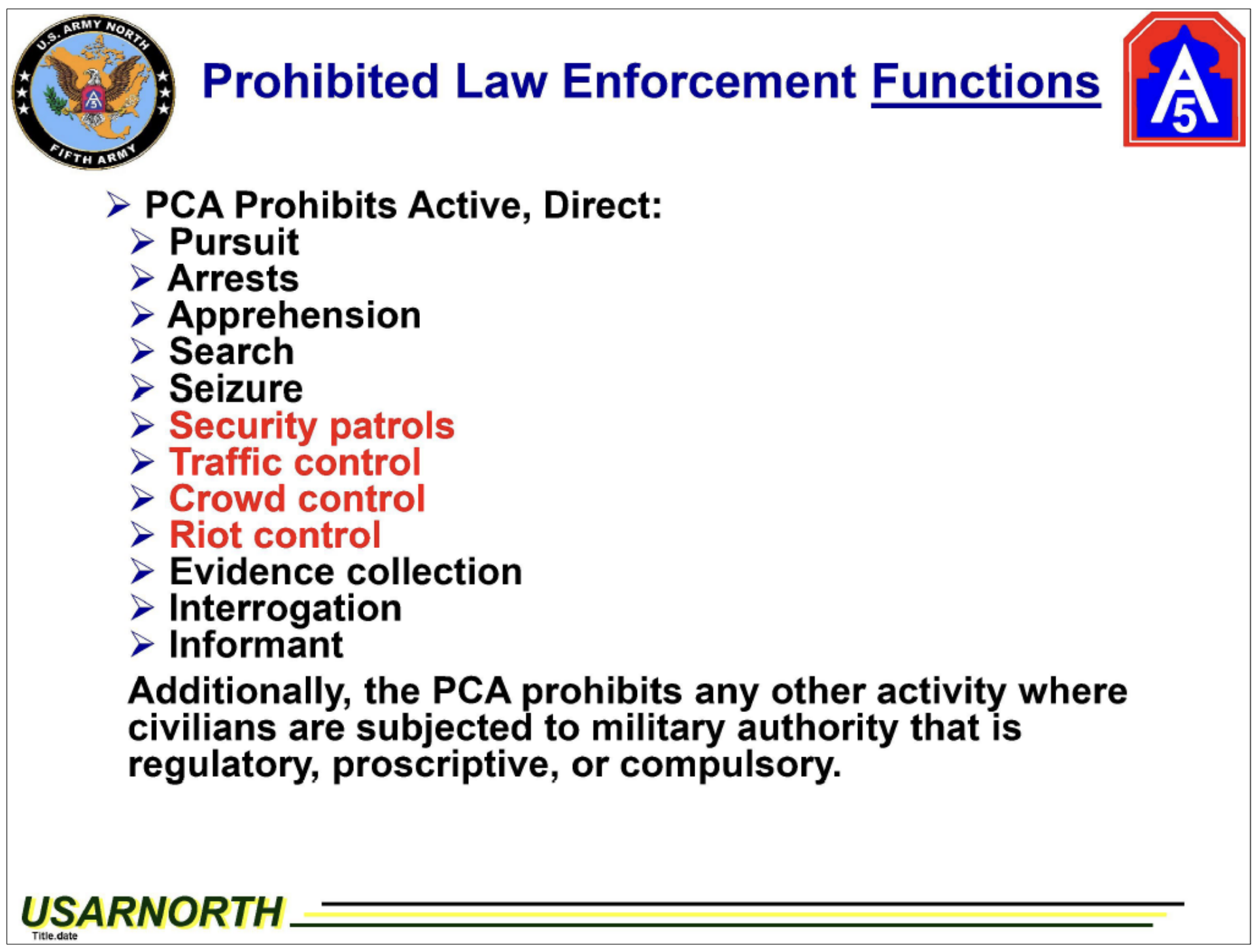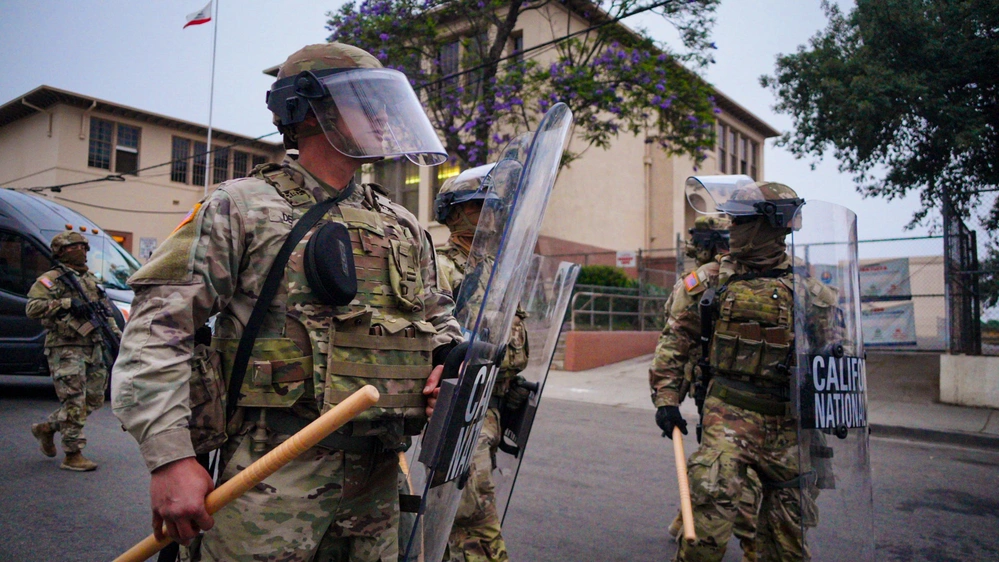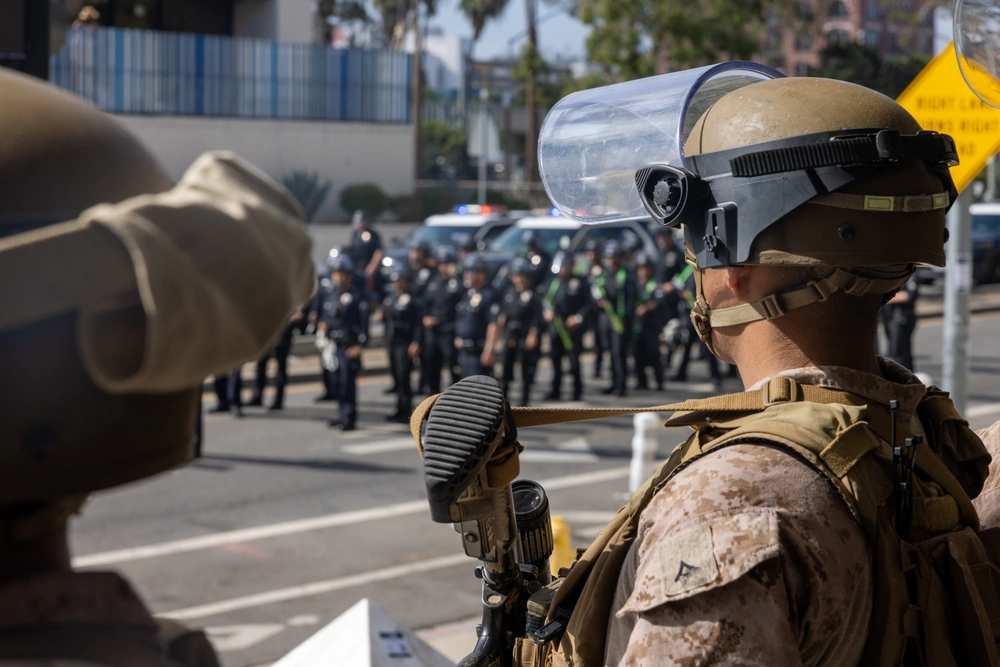Federal judge rules Trump LA military deployment violated federal law

U.S. Marines assigned to Task Force 51 guard a federal building in Los Angeles on June 14, 2025. DVIDS/Jaye Townsend
WASHINGTON, Sept. 22 (ZFJ) — A federal district judge in California ruled on Sept. 2 that President Donald Trump’s use of the California National Guard and U.S. Marines in Los Angeles violated a federal law restricting the use of the military for domestic law enforcement.
Raising concerns about Trump’s potential use of the military elsewhere in the nation, U.S. District Judge Charles R. Breyer found that Trump’s use of the soldiers violated the Posse Comitatus Act, which prohibits the use of the military for civilian law enforcement without authorization from Congress or the Constitution.
“The evidence at trial established that Defendants systematically used armed soldiers (whose identity was often obscured by protective armor) and military vehicles to set up protective perimeters and traffic blockades, engage in crowd control, and otherwise demonstrate a military presence in and around Los Angeles,” Breyer wrote in an opinion granting injunctive relief, also noting that Trump’s intention to deploy guardsmen in other states would be “creating a national police force with the President as its chief.”
Currently, 300 California National Guard troops remain federalized and on active duty in Los Angeles. Breyer neither required the government to withdraw these troops nor prohibited them from protecting federal property in compliance with the Posse Comitatus Act. However, until the government satisfies a valid exception, he issued an injunction prohibiting the use of any soldiers in California “to execute the laws,” which includes arrests and apprehensions; searches and seizures; security patrols; traffic, crowd, and riot control; evidence collection; interrogation; and acting as informants.
 California National Guard members assigned to Task Force 51 guard a federal building in Los Angeles on June 9, 2025. DVIDS/Alexander Werden
California National Guard members assigned to Task Force 51 guard a federal building in Los Angeles on June 9, 2025. DVIDS/Alexander Werden
FINDINGS OF FACT
Breyer found that there were some violent acts committed during protests against operations by U.S. Immigration and Customs Enforcement (ICE), such as the throwing of rocks and objects at federal property at the Roybal Federal Complex, where the Metropolitan Detention Center is located. The Los Angeles Police Department (LAPD) and Los Angeles Sheriff’s Department (LASD) responded to these demonstrations by dispatching additional officers, declaring an unlawful assembly, and successfully clearing the area.
Trump issued a memo to Secretary of Defense Pete Hegseth on June 7 in which he activated the National Guard, alleging that such a move was necessary to ensure ICE activity could continue and to protect federal property. He did not invoke the Insurrection Act, which would allow him to deploy troops on the basis that an ongoing rebellion against the government was underway.
Hegseth then issued a memo the same night implementing Trump’s order by federalizing 2,000 members of the California National Guard and placing them under the command of U.S. Northern Command (USNORTHCOM).
In a memo two days later, Hegseth deployed 2,000 more California guardsmen as well as 700 U.S. Marines from Camp Pendleton. These troops were placed under the command of Task Force 51, a U.S. Army North command post.
Commanding officers were in agreement that the Posse Comitatus Act applied to this deployment, so Task Force 51 troops were trained concerning what they could and couldn’t do under federal law. The responsibility for this training fell to Maj. Gen. Scott Sherman, U.S. Army North deputy commanding general for support and Task Force 51 commander.
Task Force 51’s training materials, submitted to court as evidence, instruct soldiers that the Posse Comitatus Act prohibits soldiers from executing law enforcement functions like pursuits, arrests, searches, and more. However, orders from the top of the U.S. Department of Defense (DOD) claimed that a “constitutional exception” to the act allowed soldiers to perform security patrols as well as traffic, crowd, and riot control. This order was eventually put into writing in a June 23 memo from Hegseth, which asserts that soldiers can go anywhere federal personnel go in order to protect them.
 A training slide from U.S. Army North shown to Task Force 51 soldiers. The DOD claimed that the activities in red could be performed by troops under a “constitutional exception.” CASE/ECF No. 176
A training slide from U.S. Army North shown to Task Force 51 soldiers. The DOD claimed that the activities in red could be performed by troops under a “constitutional exception.” CASE/ECF No. 176
On June 10, U.S. Army North emailed federal law enforcement agencies to “coach” them “as to what language to use when submitting requests for assistance.”
Specifically, law enforcement agencies were instructed to “[s]ubstitute ‘protection’ for security’” and “detect, monitor, and report” for “surveillance.” “If the requested activity cannot be converted to a ‘protection’ term,” the email stated, “then we cannot perform it.”
— Opinion Granting Injunctive Relief, Breyer, p. 10
While on the ground, Task Force 51 troops wore military uniforms with green or multicamouflage patterns. Some ICE agents also wore camouflage uniforms. Breyer found that “it is difficult, even for someone familiar with military uniforms and insignia, to differentiate between the uniforms from a distance or where there is a lot of commotion.” When shown photos of operations during court testimony, key federal officials were unable to distinguish between soldiers and ICE agents.
Indeed, Major General Sherman and Ernesto Santacruz—the Los Angeles field office director for ICE’s Enforcement and Removal Operations and a veteran himself—were both unable to determine whether multiple photographs of ICE enforcement actions were Task Force 51 troops or federal law enforcement personnel.
— Opinion Granting Injunctive Relief, Breyer, p. 10
Task Force 51 participated heavily in law enforcement, and they accompanied ICE agents on about 75% of their removal operations in and around Los Angeles through mid-July. The Marines were assigned only to protect federal buildings in L.A., such as the Wilshire Federal Building, at which a Marine briefly detained a veteran on June 12.
 California National Guard members protect federal law enforcement during an operation in east Los Angeles on June 12, 2025. DVIDS/Chase Murray
California National Guard members protect federal law enforcement during an operation in east Los Angeles on June 12, 2025. DVIDS/Chase Murray
One significant operation Task Force 51 participated in was a show of force, called Operation Excalibur, executed with the U.S. Department of Homeland Security (DHS) at MacArthur Park on July 7. Federal law enforcement officials marched through the park while guardsmen in military vehicles cordoned off nearby roads.
This is footage from today in MacArthur Park.
— Mayor Karen Bass (@MayorOfLA) July 7, 2025
Minutes before, there were more than 20 kids playing — then, the MILITARY comes through.
The SECOND I heard about this, I went to the park to speak to the person in charge to tell them it needed to end NOW.
Absolutely outrageous. pic.twitter.com/sxGzjGlYlr
Military operations outside of Los Angeles County included:
- A June 18 Drug Enforcement Administration (DEA) raid on a marijuana farm in Mecca, California, where troops established a security perimeter with riot shields and military vehicles.
- A July 10 Homeland Security Investigations (HSI) raid on a marijuana farm in Carpinteria, California, where troops blockaded roads.
- A July 10 federal law enforcement raid on a marijuana farm in Camarillo, California, where soldiers formed a security perimeter around the operation.
CONCLUSIONS OF LAW
With some discussion on legal precedent, Breyer establishes that the states have the requisite standing to bring this lawsuit. He then considers the president’s contention under Title 10 that he can federalize the National Guard “[w]henever … the President is unable with the regular forces to execute the laws of the United States.”
Breyer initially issued an emergency order that the troops be withdrawn, but it was overturned by the 9th U.S. Circuit Court of Appeals before the case went to trial on merits. The 9th Circuit reasoned that the president could invoke Title 10 if his ability to execute the law has been “significantly impeded.”
Breyer proposes several scenarios that would meet the 9th Circuit’s test:
- The President, relying upon IRS data showing that a sizeable percentage of corporations and individuals are using tax shelters to avoid paying taxes, could claim that he is unable to execute the tax laws.
- The President, relying upon EPA studies showing that pollution in a river cannot definitively be traced back to a specific manufacturing plant, could claim that he is unable to execute the Clean Water Act.
- The President, relying upon health data showing the number of individuals who present to hospitals with narcotic-related symptoms, could claim that he is unable to execute the federal drug laws.
- The President, relying upon anecdotes from state election officials that voting machines are glitching, or that fraud exists, could claim that he is unable to execute the election laws.
— Opinion Granting Injunctive Relief, Breyer, p. 28
Breyer rejects the 9th Circuit’s test as a “highly deferential reading of the statute” and points out that the federal government has not explained whether they believe the statute “allows federalized National Guard troops to execute any laws or just those that the President found he could not enforce” under the statute.
“The Court will not take Defendants’ invitation to create a brand-new exception to the Posse Comitatus Act that nullifies the Act itself,” writes Breyer.
The federal government did not claim to be relying on the Insurrection Act, which “sets a default presumption that state and local officers will be able and willing to protect a right, privilege, or immunity secured to the people.” Breyer writes, “this is, perhaps, a tacit admission that President Trump would be unable to make the showing, required under the Insurrection Act, to rebut the presumption that state and local officials in Los Angeles were unable or unwilling to act.”
Finding that such an interpretation of the Title 10 statute would “place no meaningful guardrails on the federalization and use of National Guard troops,” Breyer rejects it as a valid legal exception, meaning the Posse Comitatus Act does apply to Trump’s deployment.
Breyer found that the DOD was incorrect in asserting that Task Force 51 could perform certain law enforcement functions under a constitutional exception, and that “the record is replete with evidence that Task Force 51 executed domestic law in these prohibited ways.”
Such evidence includes military reports on operations in L.A., photos of operations released publicly by the military, and photos and videos taken by members of the public.
 U.S. Marines assigned to Task Force 51 guard a federal building in Los Angeles on June 14, 2025. DVIDS/Logan Courtright
U.S. Marines assigned to Task Force 51 guard a federal building in Los Angeles on June 14, 2025. DVIDS/Logan Courtright
“These violations were part of a top-down, systemic effort by Defendants to use military troops to execute various sectors of federal law (the drug laws and the immigration laws at least) across hundreds of miles and over the course of several months—and counting,” writes Breyer.
He pointed out that “defendants’ lack of cooperation with their state and local counterparts raises red flags” and highlights that the federal government did not prove that state and local officials were refusing to enforce the law.
He concludes that “Defendants knowingly contradicted their own training materials, which listed twelve functions that the Posse Comitatus Act bars the military from performing” and that “these actions demonstrate that Defendants knew that they were ordering troops to execute domestic law beyond their usual authority.”
SIGNIFICANCE
The DOD immediately appealed the case to the 9th Circuit, which administratively stayed the judge’s order “to preserve the status quo” pending further action from the appeals court on the merits of the case.
California Governor Gavin Newsom celebrated the court’s ruling as a win for democracy.
“Today, the court sided with democracy and the Constitution. No president is a king — not even Trump — and no president can trample a state’s power to protect its people,” he said in a statement.
The Associated Press reported on Sept. 2 that White House spokeswoman Anna Kelly said in a statement that “once again, a rogue judge is trying to usurp the authority of the Commander-in-Chief to protect American cities from violence and destruction.”
The case is Gavin Newsom v. Donald Trump (3:25-cv-04870-CRB) in the U.S. District Court for the Northern District of California.
References
- U.S. District Court for the Northern District of California (CAND) - Gavin Newsom v. Donald Trump (3:25-cv-04870-CRB)
- ECF No. 22-2 - OPPOSITION/RESPONSE TO MOTION - EXHIBIT 2 - Calling Members of the California National Guard into Federal Service - https://www.zfjnews.com/2025/domestic-affairs/N.D.Cal._3_25-cv-04870-CRB_22_2
- ECF No. 22-3 - OPPOSITION/RESPONSE TO MOTION - EXHIBIT 3 - Calling Additional Members of the California National Guard into Federal Service - https://www.zfjnews.com/2025/domestic-affairs/N.D.Cal._3_25-cv-04870-CRB_22_3
- ECF 127-2 - SUPPLEMENTAL BRIEF - EXHIBITS 1-30 - https://www.zfjnews.com/2025/domestic-affairs/N.D.Cal._3_25-cv-04870-CRB_127_2.pdf
- ECF 134-2 - SUPPLEMENTAL BRIEF - EXHIBITS 1-13 - https://www.zfjnews.com/2025/domestic-affairs/N.D.Cal._3_25-cv-04870-CRB_134_2.pdf
- ECF No. 153-3 - EXHIBITS TO AN ADMINISTRATIVE MOTION TO FILE UNDER SEAL - EXHIBIT 3 REDACTED - https://www.zfjnews.com/2025/domestic-affairs/N.D.Cal._3_25-cv-04870-CRB_153_3.pdf
- ECF No. 153-6 - EXHIBITS TO AN ADMINISTRATIVE MOTION TO FILE UNDER SEAL - EXHIBIT 6 REDACTED - https://www.zfjnews.com/2025/domestic-affairs/N.D.Cal._3_25-cv-04870-CRB_153_6.pdf
- ECF No. 153-18 - EXHIBITS TO AN ADMINISTRATIVE MOTION TO FILE UNDER SEAL - EXHIBIT 18 REDACTED - https://www.zfjnews.com/2025/domestic-affairs/N.D.Cal._3_25-cv-04870-CRB_153_18.pdf
- ECF No. 153-19 - EXHIBITS TO AN ADMINISTRATIVE MOTION TO FILE UNDER SEAL - EXHIBIT 19 REDACTED - https://www.zfjnews.com/2025/domestic-affairs/N.D.Cal._3_25-cv-04870-CRB_153_19.pdf
- ECF No. 153-21 - EXHIBITS TO AN ADMINISTRATIVE MOTION TO FILE UNDER SEAL - EXHIBIT 21 REDACTED - https://www.zfjnews.com/2025/domestic-affairs/N.D.Cal._3_25-cv-04870-CRB_153_21.pdf
- ECF No. 153-34 - EXHIBITS TO AN ADMINISTRATIVE MOTION TO FILE UNDER SEAL - EXHIBIT 34 REDACTED - https://www.zfjnews.com/2025/domestic-affairs/N.D.Cal._3_25-cv-04870-CRB_153_34.pdf
- ECF No. 153-35 - EXHIBITS TO AN ADMINISTRATIVE MOTION TO FILE UNDER SEAL - EXHIBIT 35 REDACTED - https://www.zfjnews.com/2025/domestic-affairs/N.D.Cal._3_25-cv-04870-CRB_153_35.pdf
- ECF No. 154 - EXHIBIT LIST - https://www.zfjnews.com/2025/domestic-affairs/N.D.Cal._3_25-cv-04870-CRB_154_0.pdf
- ECF No. 176 - OPINION GRANTING INJUNCTIVE RELIEF - https://www.zfjnews.com/2025/domestic-affairs/N.D.Cal._3_25-cv-04870-CRB_176_0.pdf
- ECF No. 194 - USCA ORDER - https://www.zfjnews.com/2025/domestic-affairs/N.D.Cal._3_25-cv-04870-CRB_194_0.pdf
- Mayor Karen Bass - @MayorOfLA (X) - https://x.com/MayorOfLA/status/1942296116378362055 This is footage from today in MacArthur Park.
- The Associated Press - Marines temporarily detain man while guarding LA federal building - https://apnews.com/article/los-angeles-marines-man-detained-491a1a6a1328ade60cb3e2e341336e53 (ARCHIVE)
- The Associated Press - Troops and federal agents briefly descend on LA’s MacArthur Park in largely immigrant neighborhood - https://apnews.com/article/california-immigration-raid-troops-military-2d81f5c35f9d11db9e32234e03480497 (ARCHIVE)
- The Associated Press - Appeals court temporarily blocks judge’s ruling to return control of National Guard to California - https://apnews.com/article/california-immigration-national-guard-newsom-trump-lawsuit-aedf8cdd95ee899c9559d5e54a2e4833 (ARCHIVE)
- California Office of the Governor - Governor Newsom secures federal court victory, Trump’s use of National Guard in Los Angeles illegal - https://www.gov.ca.gov/2025/09/02/governor-newsom-secures-federal-court-victory-trumps-use-of-national-guard-in-los-angeles-illegal/ (ARCHIVE)
